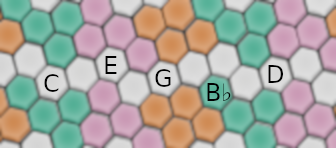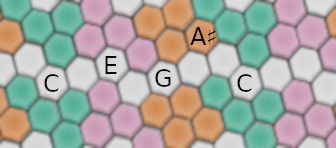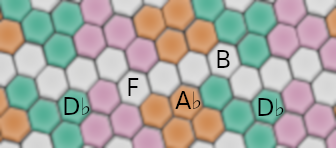Here are some tips on using magic temperament with a Lumatone, which is a fancy new generalized keyboard. Magic has good approximations to simple harmonic ratios, including the ones traditional Western Countries music seems to refer to and doesn't get too complicated. I've been concentrating on magic for several years now so I know the ins and outs of it. It isn't meantone, which means you have to deal with two sizes of whole tone. I've got a page with suitable tuning files
The original Preset 4 is a mapping for 19 notes to the octave with a Bosanquet layout. It's called 19-ET but there's no need to tune it to equal temperament. Because the Bosanquet layout is designed for a tuning generated by fifths, this is really a meantone mapping. Magic has a 19 note MOS, so you can fit it to this mapping and everything will be consistent with the keyboard geometry. Once you find the shape for a chord, every chord like that will have the same shape, but some chords like that will be out of tune because it isn't equally tempered.
The Bosanquet layout doesn't have any special meaning with magic temperament. It will help for following conventional notation with sharps and flats but even then it doesn't help much. You can play music as written as if it were meantone, and it will either work or it won't. You have to be aware of which chords are going to work and which won't, which means you have to do some theoretical work. The colours include a diatonic scale, which is useful to orient yourself. Remember that, what with this not being a meantone, not all diatonic chords are going to be in tune. My 19 note tunings include some for the key of C with different tunings of D. D is 10/9 for the ii chord and 9/2 for the V chord.
I developed tripod notation for magic temperaments. The details don't concern us now. The principle is that the octave is divided into three feet, each pitch sits on a foot, and knowing the position on a 19 note scale and the foot is enough to tell you what pitch you have in magic temperament. A 5-limit triad should have one pitch on each foot. So, what I did is made a Lumatone mapping where there are three colours, one for each foot, to help you orient yourself. There are a few national flags that have three vertical stripes of different bright colours, but they tend to include white, which is better for the "white keys", or mix red and blue or green. I chose a colour-blind safe palette that's vaguely Irish or Côte d'Ivoirian. If you don't have a Lumatone try it out on, or the editor, here's what it looks like.

The white notes from the piano are, following logic that it would take too long to explain, coloured white. The other colours I'll call green, pink, and orange. The specific colours don't matter, only that they're different. This mapping is for 19 notes, and the pitches are the same as for Mike Battaglia and Cam Taylor's Preset 4, so you can use the same tuning, and specifically one of my "C" tuning files. They differ by the D tuning, and conveniently D is a white note, so it gets left ambiguous about what foot it's on. It's consistent with Preset 4: the diatonic scales are the same.
The specific colour scheme I use is taken from the Color Universal Design palette and is like this, with hex values if you want to copy it.
| My name | Official Name | Hex |
|---|---|---|
| Green | Bluish Green | 009e73 |
| Pink | Reddish Purple | CC79A7 |
| Orange | Orange | D55E00 |
To demonstrate how harmony works out, here's a C9 chord.

The C, E, and G sit on different colours, so the 5-limit basis is correct. The B♭ is green and the G is orange. These are consecutive colours, so G to B♭ is a 6:5 minor third. C to B♭ is the wider kind of minor seventh: an approximate 9:5. The colour of D is ambiguous: it's above a green key and below a pink key. As explained before, it depends on what tuning you chose. For the obvious tuning of 9/4 above C, it should be on a different colour to C and B♭, and so pink.
Now, Lumatone users are a sophisticated lot and aren't going to be too concerned with diatonic, 5-limit based harmony. Let's try a C harmonic seventh (4:5:6:7) chord.

The rule for 7-limit harmony in tripod notation is simple: you choose the right 7-limit meantone pitches and put 4 and 7 (or 7 and 8) on the same foot (or wheel for tricycle notation). Here, A♯ is orange and C is green, so this is not the correct 7-limit tuning. To get a correctly tuned chord, move it to D♭, which is the tritone substitute of the dominant, G.

The 5-limit part checks out: D♭, F, and A♭ are on the same colours as C, E, and G. Now, though, the root and the seventh are both green, and we can conclude that this is a correctly approximated harmonic seventh chord.
As a real Lumatone sophisticate, you'll already be thinking "I thought magic temperament worked in the 11-limit; where are the 11-limit chords?" And, indeed, you are correct. Here is an 11-limit C+11.

The harmonic 11th is an augmented 11th on the same foot as the third, and the same foot as a Pythagorean perfect 4th would have been. That means the augmentation keeps you on the same foot.
The tuning of the ninth here is ambiguous according to the keyboard. If it's going to be a 9:4 interval, which fits the otonal pattern, it has to be pink. That tells us that the 11:9 neutral third is between two pink notes, and so is another foot conserving interval that looks like a major third. It happens, because magic temperament is generated by major thirds, that you only get one of these neutral thirds within the 19 note gamut. Have a look at the diagram and see if you can find the neutral third when D is green.
The Bosanquet layout can work for magic temperament, but it's really borrowed from meantone. There are also mappings that follow simple intervals in magic temperament. As the octave-equivalent magic generator is a major third, these will have major thirds running in one direction and the result will look like a lattice or Tonnetz. A lattice has major thirds in one direction and minor thirds in the other, so that it's also easy to find perfect fifths and triads. However, between the major and minor thirds, you have a chromatic semitone. This means that a lattice layout is not only for harmony. In magic temperament, the chromatic semitone or semitoe is a simple interval. An octave is three major thirds plus a semitoe. The mapping works as major thirds in one direction and semitoes in the other.
I like the major thirds to map like whole tones and the semitoes to be connected steps on the keyboard. That leaves two different options and because they're slanted differently, one works better with the left hand and the other works better with the right hand. They're both more compact than Bosanquet so you get more than 5 octaves across the keyboard. That means there's space for both of them on the keyboard at the same time, so I do that. Here's what they look like, with some of the notes written in and a line drawn between the sections.

To play this, get the 19-note lattice-based Lumatone mapping and two-channel ZynAddSubFX file for 19 notes of magic temperament. It's pitched with note 60 as C. The ZynAddSubFX file uses the same instrument in different registers with overlap between the channels. You could load two different instruments and treat it as a split keyboard.
The tricolour colouring shows you where the semitoes run. You can see that the D keys are approached by different colours from different directions, which shows that D is ambiguous. The tuning I used makes it green for 10/9.
The same lattice patterns work for 22 notes. Get the 22-note lattice-based Lumatone mapping and two-channel ZynAddSubFX file for 22 notes of magic temperament. These are also pitched on C as note 60, but to use it with a "C" tuning, set the reference pitch as E on note 67. E can be tuned to 330 or 660 Hz.
Here's the picture of the keyboard with the split shown and some pitches written in.

There are two different tunings of D and they can both be white because you can tell what colour each should be from the other keys. A lot of other patterns are the same with the three extra notes added.
Here are the same lattice patterns as before for 41 notes. Get the 41-note lattice-based Lumatone mapping and multi-channel ZynAddSubFX file for 41 notes of magic temperament. These are also pitched on C as note 60. You could tune it to 41 note equal temperament. If you want a different magic tuning, make it symmetrical about C. This is a bit crazy. I think it covers all 41 notes somewhere on the keyboard. It still basically works.

Here's one more mapping for 41. 41-note special Lumatone mapping. You can use the ZynAddSubFX configuration I gave before: it was specially prepared with a different instrument on the extra channels. The mapping is a rotated version of the right-handed lattice that means the semitoes run along the long axis of the keyboard. That gives you all 41 notes clearly running across the keyboard with a lot of duplicates for ease of use. It works a lot like The Kite Guitar. You don't get as many "frets" but you do have more "strings" so it's more like a Kite archlute. In fact, it looks like it qualifies as a Kite-tuned Keyboard.
